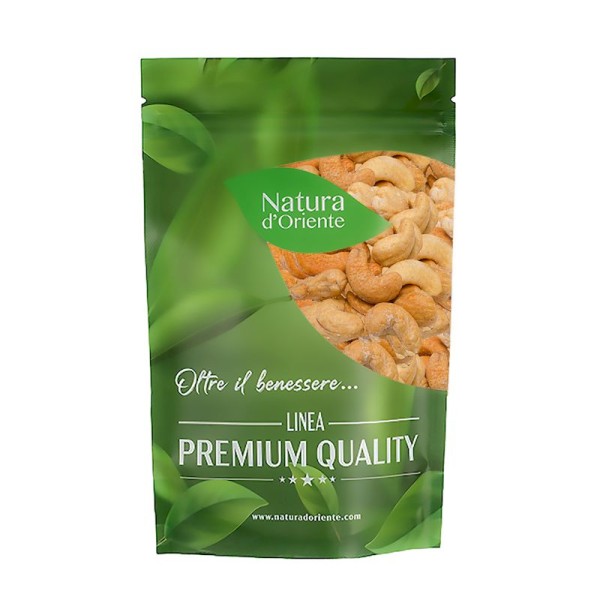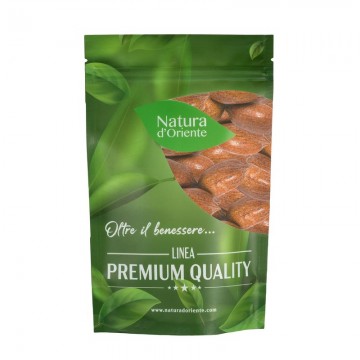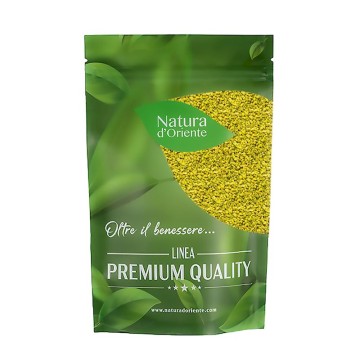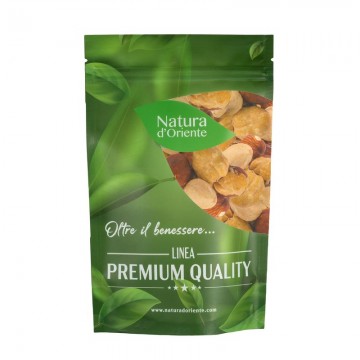Cashews are a type of dried fruit originally from South America and precisely from Brazil, but after they were brought back to Europe by the Portuguese it spread to all areas of the world with a favorable. The properties and nutritional characteristics are those typical of dried fruit.
Roasted cashews properties and benefits
And let's see these properties: very caloric because rich in fats but considered valuable foods because monounsaturated and polyunsaturated fats, the so-called good fats, prevail by far . Good content of vitamins and mineral salts, but a clarification must be made: the values of the nutrients change between raw product (practically impossible to find in Europe) and toasted one. As is known, for example, many vitamins are thermolabile, home cooking destroys them all, while in industrial processes, technology today allows a certain degree of preservation. We obviously refer to the values for the roasted product and the biggest difference is the vitamin C which is completely absent. As far as the mineral salts are concerned, iron appears to be of an average bioavailable type.
Nutritional values of salted roasted cashews
In the typical ration of one hundred grams of roasted cashews you will find 574 kilocalories. 46 grams of fat, but of these only 9 are made up of the infamous saturated fats, just over 27 grams are monounsaturated fats and just under 8 polyunsaturated fats. Among the vitamins stand out those of group B, B3 (niacin) with 1.40 mg which represent 5.56 of the daily requirement of an adult (18 mg). The content of B2 and B1 is 0.2 mg in both cases. The correct intake of vitamin B2 in the diet is considered to be 0.6 mg for every 1000 calories (the caloric requirement of an adult varies according to age and physical activity level of course, it can be less than 2000 calories for those who does a sedentary job and little exercise and can be around 3500 and over for those who have an active life and do at least 5 hours of sport a week). Also stand out the 69 micrograms of folic acid (vitamin B9). Among the mineral salts, 6 mg of iron, 565 mg of potassium, 490 mg of phosphorus and 260 mg of magnesium.
History and cultivation
As anticipated in the introduction, cashews are originally from Brazil, to be precise the northeastern part of the great South American country, Portuguese colonists began exporting cashews as early as 1550. Between the 1560 and 1565 introduced the plant to Goa and from there it spread throughout Southeast Asia and then to Africa. The result of this widespread diffusion is that currently (data from 2019) the native Brazil in the ranking of cashew producers is only in tenth place, the top 9 positions are equally divided between Asian and African countries, with Ivory Coast leading the ranking.
Roasted Cashews in the diet
As we have seen cashews are full of good fats, in the traditional Mediterranean diet this task of providing good fats is carried out by extra virgin olive oil and therefore you would risk exaggerating but if you contain the use of oil in a balanced diet you could also use them for that purpose, otherwise the same goes for other dried fruit, they can be an energetic snack and break hunger, particularly healthy and suitable for those who do sport also thanks to the content of mineral salts.
Plant and fruit
Western Anacardium of the Anacardiaceae family is an ever green tropical tree. It is an imposing tree in terms of width rather than height, the height can still reach 14 meters, with an irregularly shaped and massive trunk and a very wide crown. What you may not know is that if we in Europe are used to eating toasted seeds, in reality the tree is cultivated both for the edible seed and for the fruit and the western name is due precisely to the shape of the fruit that can vaguely remember that of a heart, the seed is on top of the fruit.
Roasted cashews with salt in the kitchen
Cashews can of course be eaten alone but in the kitchen they are quite used in traditional recipes around the world, especially Asian, as in chicken with cashews, but we have chosen a vegetarian version of samosas. What are samosas? Tasty stuffed dumplings that are a very popular street food especially in the Indian subcontinent. The rThe filling recipe varies from place to place and we could even say that every family has its own.
Samosa (vegetarian version)
Ingredients for the dough (quantity for 8 SAMOSA)
- 00 flour 250 gr
- Water 100 ml
- Seed oil 50 ml
- Salt up to 1 pinch
- For the filling
- Potatoes 370 gr
- Peas 107 gr
- Cashews 35 gr
- Fresh ginger 27 gr
- Onions ½
- Garlic 2 cloves
- Fresh chilli ½
- Cumin ¼ tsp
- Turmeric powder ¼ tsp
- Chilli powder 1 pinch
- Extra virgin olive oil 10 gr
- Salt to taste
- For frying
- Seed oil 1 lt
Preparation
1) Wash and peel the potatoes and boil them in a pot of boiling water for 35 minutes
Preparing the samosa dough
2) Combine the flour, salt and seed oil in a large pot and begin to mix the ingredients with your fingertips.
3) Add the water a little at a time, continuing to knead with your hands until you get a ball of fairly smooth and elastic dough.
Cover the bowl with a cloth and proceed with preparing the ingredients for the filling
4) Cut the fresh pepper in half lengthwise, remove the seeds with the blade of a knife and cut it into small pieces;
5) Peel the onion and cut it into thin slices
6) Coarsely chop the cashews with a knife 11.
7) After cooking, drain the potatoes.
Preparation of the filling
8) Heat the olive oil in a saucepan and add the crushed garlic, grated ginger and fresh chilli
9) Brown over medium heat for a couple of minutes, stirring often.
10) Add the onion to the sauté, together with the chilli powder and turmeric and let them brown for a few minutes, stirring often.
11) Add the whole boiled potatoes and mash them coarsely with a ladle.
12) After 6-7 minutes add the peas 21 and cook for about 3 minutes
13) Turn off the heat and add the chopped cashews and cumin
14) Mix well and season with salt.
15) When the filling is ready, take the dough ball and divide it into 4 equal parts
16) Wait each of them with a rolling pin to form a circle with a diameter of about 20 cm 24.
17) Cut the circle in half, take one of the 2 semicircles obtained and position it with the right side up.
18) Brush the upper left side with water, then fold it and bring it towards the center of the semicircle.
19) Brush with water the edge of the dough that is now on the half of the semicircle, then bring the right end towards the center too, matching the two sides and pressing gently to glue them.
20) In this way you will have obtained a cone: lift it gently and place it in the hollow of your hand
21) Fill it with the filling up to a couple of cm from the edge.
22) Press the edges with your fingers to seal the opening, then fold the edge back on itself and press once more to seal it further.
23) When all the samosas are assembled, heat the seed oil in a saucepan until it reaches a temperature of 170 °, then fry one piece at a time (or at most 2, to prevent the oil temperature from dropping) for about 3 minutes by turning it on both sides.
24) When the samosa has taken on a beautiful golden color, drain it with a skimmer and transfer it to absorbent paper to absorb excess oil.













 No reward points for this product.
No reward points for this product.















